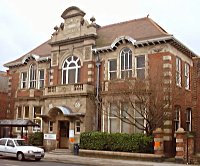
Wedged into an unpromising Fratton Road site across from the former graveyard of St. Mary's Church and a next to a low rent cinema later recycled as a snooker hall and now a block of flats,
this Carnegie branch library is a gem. The façade – a mix of Edwardian baroque and free Renaissance styles is pretentiously grandiose, given the scale of the building behind; but if it is overblown then this could be excused as loud proclamation of Andrew Carnegie's faith in the transformative power of books.

The plutocrat benefactor was born into a Fife linen weaver's family in Dunfermline in 1835. Steam technology-driven redundancy drove the family into taking their chances in Pennsylvania in 1848. Andrew went on to become a folkloric example of the poor immigrant boy made good in America. He went from telegraph messenger boy to owner of the United States' largest steel works in twenty-five years. When he eventually came to sell his steel company to J.P.Morgan in 1901, the $480m sale made him the richest man in the world.
The possible reason that Carnegie's story has not been more celebrated, particularly in Gosford Park upper circles, is due to his beneficent behaviour and the thinking that informed it. In his book - The Gospel of Wealth – Carnegie outlined the bizarre even dangerous notion that the rich were morally obliged to use their money to help those who were less fortunate. That he meant what he said was born out by a campaign of cultural philanthropy; between 1886 and 1917 the Carnegie Foundation funded the building of one thousand six hundred and seventy nine free libraries in America and six hundred and sixty in Britain.
These libraries provided female white-collar work, were some of the first public buildings to dedicate space to the needs of children and crucially provided library facilities to those too poor to own a library. They were truly the 'street corner universities' of their time.

In Portsmouth, Carnegie provided the funds, the Council provided the land and architects Rake and Cogswell provided their design services for free. Eleven months after the start of building work, the library opened on 12th. September 1906. the brief called for a newspaper room, a magazine room, a ladies reading room, a top-lit lending library room and a lecture room on the upper floor where the Workers Educational Association held classes in industrial economics.
At first the loan system was on a closed-access basis, where the reader chose a book from a catalogue and checked the book's availability on an indicator board. In 1920 the Library became the first in the city to change to an open access system of book selection. Still from their central issue desk, librarians had good surveillance lines along the sets of patent iron shelving.
The building is worth a visit to view the original stained glass interior doors, two
remaining iron shelving bays and the original issue pen; it provides a fascinating glimpse of an earlier architecture of improvement. [ open: Monday, Wednesday and Friday 10.00 – 7.00 & Saturday 10.00 – 1.00 pm ]